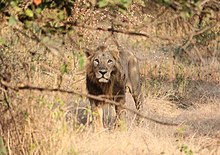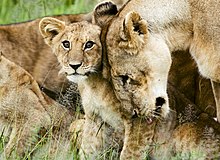😃😃LION😃😃
ABOUT IT
The lion (Panthera leo) is a species in the family Felidae; it is a muscular, deep-chested cat with a short, rounded head, a reduced neck and round ears, and a hairy tuft at the end of its tail. It is sexually dimorphic; adult male lions have a prominent mane, which is the most recognisable feature of the species. With a typical head-to-body length of 184–208 cm (72–82 in) they are larger than females at 160–184 cm (63–72 in). It is a social species, forming groups called prides. A lion pride consists of a few adult males, related females and cubs. Groups of female lions usually hunt together, preying mostly on large ungulates. The lion is an apex and keystone predator, although some lions scavenge when opportunities occur, and have been known to hunt humans, although the species typically does not.
Subspecies
In the 19th and 20th centuries, several lion type specimens were described and proposed as subspecies, with about a dozen recognised as valid taxa until 2017.[1] Between 2008 and 2016, IUCN Red List assessors used only two subspecific names: P. l. leo for African lion populations and P. l. persica for the Asiatic lion population.[2][15][16] In 2017, the Cat Classification Task Force of the Cat Specialist Group revised lion taxonomy, and recognises two subspecies based on results of several phylogeographic studies on lion evolution, namely:[17]
- P. l. leo (Linnaeus, 1758) − the nominate lion subspecies includes the Asiatic lion, the regionally extinct Barbary lion,
- and lion populations in West and northern parts of Central Africa.[17] Synonyms include P. l. persica (Meyer, 1826), P. l. senegalensis (Meyer, 1826), P. l. kamptzi (Matschie, 1900), and P. l. azandica (Allen, 1924).[1] Some authors referred to it as 'northern lion' and 'northern subspecies'.
Fossil records
Other lion subspecies or sister species to the modern lion existed in prehistoric times:[22]
- P. l. sinhaleyus was a fossil carnassial excavated in Sri Lanka, which was attributed to a lion. It is thought to have become extinct around 39,000 years ago.[23]
- P. leo fossilis, P. fossilis or P. spelaea fossilis was larger than the modern lion and lived in the Middle Pleistocene. Bone fragments were excavated in caves in the United Kingdom, Germany, Italy and Czech Republic.[24][25]
- Panthera spelaea lived in Eurasia and Beringia during the Late Pleistocene. It became extinct due to climate warming latest by 11,900 years ago.[26] Bone fragments excavated in European, North Asian, Canadian and Alaskan caves indicate that it ranged from Europe across Siberia into western Alaska.[27] It likely derived from P. fossilis,[28] and was genetically isolated and highly distinct from the lion in Africa and Asia.[29][28] It is depicted in Paleolithic cave paintings, ivory carvings, and clay busts.
Distribution and habitat
African lions live in scattered populations across Sub-Saharan Africa. The lion prefers grassy plains and savannahs, scrub bordering rivers and open woodlands with bushes. It is absent from rainforest and rarely enters closed forest. On Mount Elgon, the lion has been recorded up to an elevation of 3,600 m (11,800 ft) and close to the snow line on Mount Kenya.[46] Lions occur in savannah grasslands with scattered acacia trees, which serve as shade.[74] The Asiatic lion now only survives in and around Gir National Park in Gujarat, western India. Its habitat is a mixture of dry savannah forest and very dry, deciduous scrub forest.
Communication
When resting, lion socialisation occurs through a number of behaviours; the animal's expressive movements are highly developed. The most common peaceful, tactile gestures are head rubbing and social licking, which have been compared with the role of allogrooming among primates.[169] Head rubbing – the nuzzling of the forehead, face and neck against another lion – appears to be a form of greeting[170] and is seen often after an animal has been apart from others or after a fight or confrontation. Males tend to rub other males, while cubs and females rub females.[171] Social licking often occurs in tandem with head rubbing; it is generally mutual and the recipient appears to express pleasure. The head and neck are the most common parts of the body licked; this behaviour may have arisen out of utility because lions cannot lick these areas themselves
SOME AMAZING IMAGES OF LION


HOPE YOU HAVE ENJOYED IT😃




WHO LIKE LION COMMENT DOWN BELOW
ReplyDelete